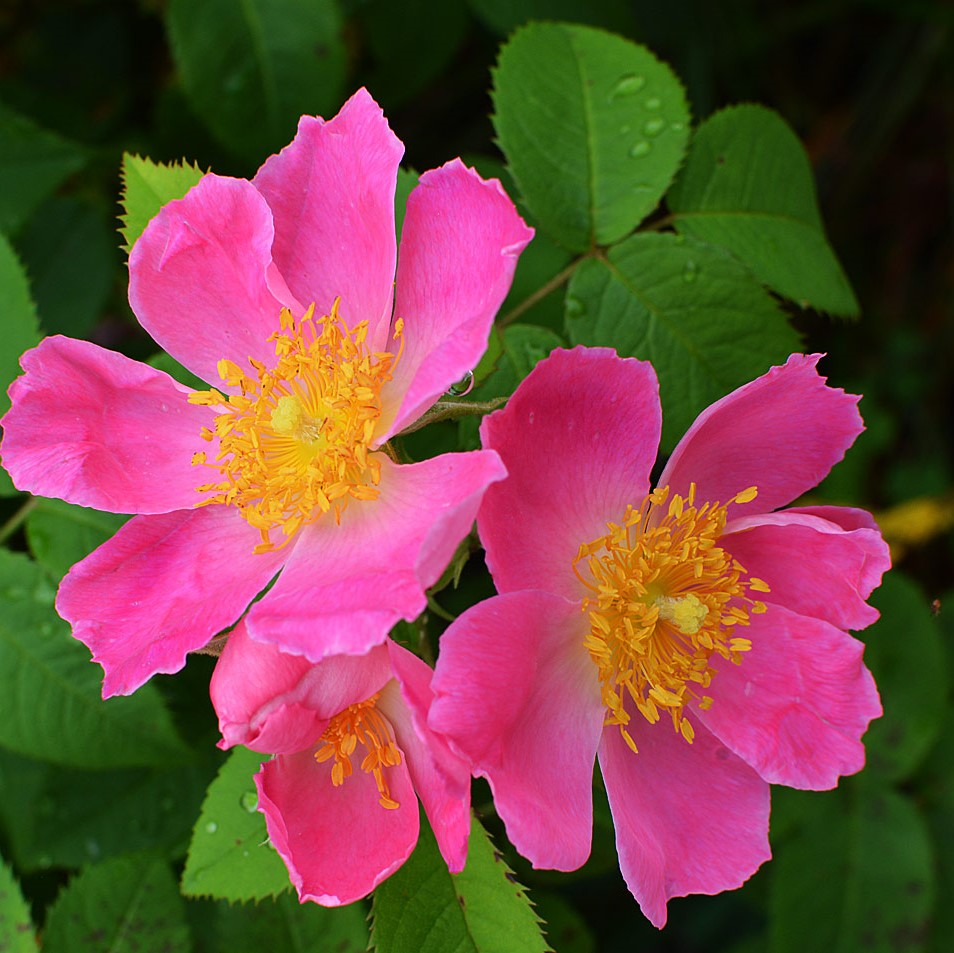The name "Gallica" was given to the wild variety of this rose by the Swedish botanist Charles Linneus (1707 - 1778), who had received a specimen from France: previously the botanical name was "R. rubra". The species "R. gallica" does not originate from France: it was probably native from Middle East, if not from the Caucasus. It is found in the wild in the Caucasus, in the North ofAnatolia, in the Balkans, in Greece, Austria, Switzerland, Italy. France, Spain, Portugal.. In Central Italy we have found wild Gallicas in Umbria, Latium and Tuscany.
"R. gallica" has been in cultivation for many centuries.
Plinius the Elder in the 1st century a.D. described two roses which seem to be Gallicas; one from Praeneste (near Rome), one from Miletus (Western Anatolia). Charlemagne in 814 a.D. ordered that roses of this type be grown on royal estates. Botanists from the Renaissance described these roses, giving them different names, among which "R. rubra" was most common. During the 18th century Dutch and Belgian nurserymen (but Belgium at that time was called Austrian Low Countries) started to hybridize Gallicas, as well as Centifolias, which were their creation, and to sell them to French nurserymen: at the end of the century at least 100 varieties of Gallicas were on sale in France. The zenith of the fortune of Gallicas in France coincided with the "Continental Block" which precluded from the French market roses obtained in England; however the greatest impulse to the diffusion of roses was given by Marie-Josephe-Rose Tascher de la Pagerie, widow of Count Beauharais, Napoleon's first wife, who loved them to the point of giving her son the name "Eugène Rose". She had in her garden at La Malmaison, near Paris, a large collection of roses, most of them Gallicas. The French imitated the Empress, and a mania for these roses ensued: in the middle of the 19th century more than 2000 varieties of Gallicas were on sale in France.
The features
Gallicas are called Tetraploids, like Damasks and Centifolias, because their cells hold four series of seven chromosomes. This affinity with Damasks and Centifolias, especially in the early 19th century, because of the haphazard way French nurserymen obtained their seedlings, is responsible for a lot of spontaneous hybrids between these three classes of roses, and explains why so many Gallicas have some features of Centifolias and Damasks.
Gallicas have some features in common: first, none of them are climbers and none of them repeat (although some French nurserymen called "Gallique Remontante" some of their creations). Second, their colours go from pale pink to scarlet, purple-red, magenta. A few are white or whitish ("Blanchefleur". "Chloris* "Comtesse de Lacépède"), obviously with Centifolia and Alba.
Gallicas are called Tetraploids, like Damasks and Centifolias, because their cells hold four series of seven chromosomes. This affinity with Damasks and Centifolias, especially in the early 19th century, because of the haphazard way French nurserymen obtained their seedlings, is responsible for a lot of spontaneous hybrids between these three classes of roses, and explains why so many Gallicas have some features of Centifolias and Damasks.
Gallicas have some features in common: first, none of them are climbers and none of them repeat (although some French nurserymen called "Gallique Remontante" some of their creations). Second, their colours go from pale pink to scarlet, purple-red, magenta. A few are white or whitish ("Blanchefleur". "Chloris* "Comtesse de Lacépède"), obviously with Centifolia and Alba features: we describe them in this section because they have a faint pink hue, especially
"Comtesse de Lacépède". Gallicas form thick erect shrubs, and generally grow to m. 1,20 - 1,30, but a few varieties can grow to m. 1,80. Their branches are green on one side, brown on the other, with some medium size hooked thorns, bristles, dark green leaves with 5 to 7 ellipse shaped leaflets. The "species" and "first hybrids" of Gallicas produce simple, five petal, or semi-double flowers, but the more sophisticated garden varieties have double flowers with lots of petals, often "quartered" or "turbinated", some with an eye in the centre. Gallicas generally have a wonderful scent, albeit lighter than Damasks.
In the second half of the 19th century Gallicas fell out of fashion, superseded by repeating classes of roses: today, out of the thousands produced before 1850, only about one hundred are still in cultivation. However some beautiful new Gallicas have been introduced by great nurserymen in the last 50 years. Kordes in 1952 introduced "Scharlachglut", with large simple red flowers; Austin in 1961 created the tall "Constance Spry" with very double pink flowers and a darker centre, in 1967 "Chianti", a shapely shrub with double crimson flowers, in 1970 Chaucer" with double pink flowers; Beales in 1982 introduced the semi-double "James Mason", with a marvelous red hue.

